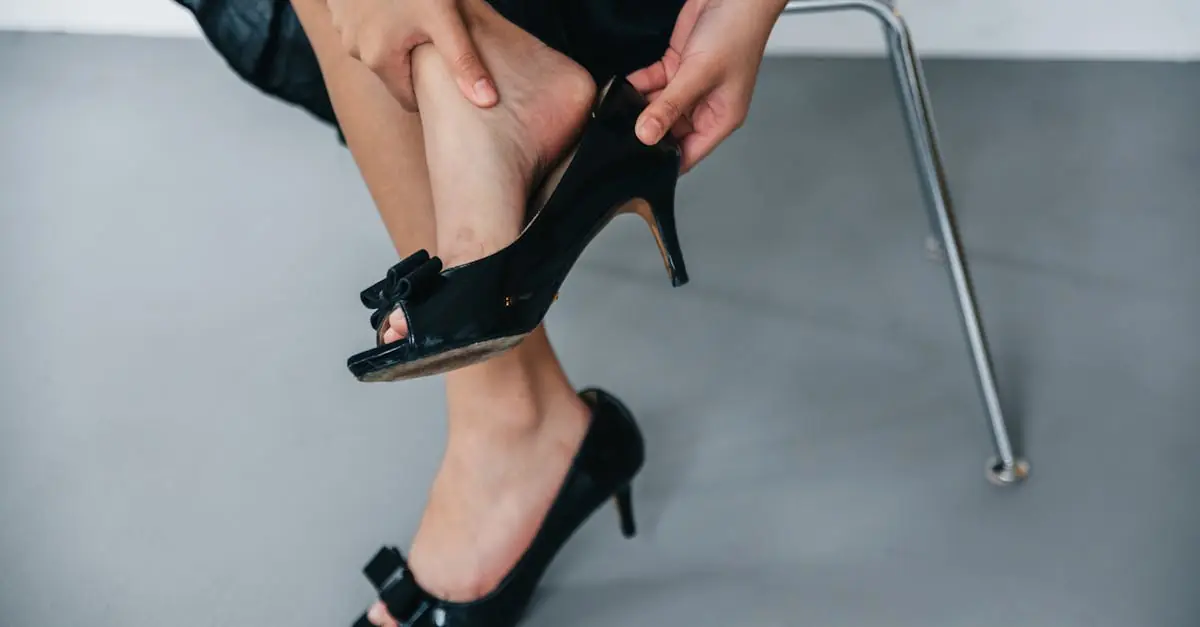Table of Contents
ToggleImagine walking into a friend’s home and being greeted by the aroma of freshly baked cookies, only to be met with a stern “Shoes off, please!” It might sound like a scene from a sitcom, but the shoes off policy is becoming a household staple. This quirky rule isn’t just about keeping floors clean; it’s a ticket to a more relaxed, hygienic, and inviting atmosphere.
In a world where everyone’s got a story about that one time they tracked mud across a pristine carpet, embracing the shoes off policy might just save friendships—and carpets. Whether it’s for health reasons or simply to keep the vibe cozy, this trend is here to stay. So kick off those shoes, let your toes breathe, and discover why this policy might just be the best thing since sliced bread (or at least since the invention of indoor slippers).
Understanding Shoes Off Policy
The “shoes off” policy refers to the practice of removing shoes before entering a home. This approach emphasizes cleanliness and hygiene, aiming to keep indoor environments free of outdoor contaminants.
Definition of Shoes Off Policy
A shoes off policy generally requires guests to leave their shoes at the entrance of a home. It aims to minimize dirt and allergens brought in from outside. Many households adopt this approach to maintain a clean living space. People often provide alternatives, like indoor slippers, to make guests comfortable. Benefits include reduced wear on flooring and carpets, contributing to longer-lasting home furnishings.
Historical Context
Historically, cultures across the globe practiced shoe removal before entering homes. In many Asian countries, customs dictate leaving shoes at the door. This tradition prioritizes cleanliness and respect for the household. During the past few decades, this practice has gained traction in Western cultures. Increasing awareness of hygiene in public health has propelled the adoption of this policy. More homeowners seek simple measures to improve indoor air quality while fostering a welcoming environment.
Benefits of Shoes Off Policy
The shoes off policy offers various advantages, primarily focusing on hygiene, cleanliness, and cultural practices. Understanding its benefits can elevate the overall ambiance of any home.
Hygiene and Cleanliness
This policy significantly reduces the amount of dirt and allergens entering indoor spaces. Shoes carry contaminants from outside, including bacteria and pesticides, which can jeopardize health. Removing footwear at the entrance helps maintain cleaner floors and air quality. A study by the American Journal of Infection Control revealed that shoes harbor harmful bacteria, emphasizing the need for this practice. Guests often appreciate the invitation to remove shoes, fostering a healthier environment for everyone in the household.
Cultural Significance
Shoes off practices hold deep cultural roots in various societies. In many Asian cultures, removing shoes symbolizes respect and cleanliness. Homes in Japan and Thailand commonly enforce this tradition, demonstrating its importance in daily life. People in these cultures often view shoe removal as a gesture of hospitality. With the rising popularity of this policy in Western settings, it bridges cultural gaps and promotes understanding. Embracing this practice can enhance domestic harmony while honoring diverse customs.
Drawbacks of Shoes Off Policy
The “shoes off” policy presents challenges despite its numerous benefits. Certain aspects may hinder its widespread adoption.
Accessibility Issues
Accessibility can become problematic with a shoes off policy. Individuals with mobility challenges may struggle to remove shoes quickly or effectively. Guests who wear orthotic devices might feel uncomfortable or even vulnerable when required to take off their shoes. Homes with limited space at the entrance may not provide sufficient room for shoe storage, making it inconvenient for some. Friends who visit frequently might hesitate due to these accessibility challenges, creating potential barriers to social interactions.
Comfort Concerns
Comfort also poses a concern regarding the shoes off policy. Many people prefer their shoes for support and stability, especially those with existing foot conditions. Cold floors can become an issue for guests during colder months, potentially leading to discomfort or even health concerns. Indoor slippers offer a solution, but not everyone enjoys using them or finds them suitable. Removing shoes can create a divide, as some guests may prefer to keep their footwear on for familiarity and comfort. These varying preferences can complicate social dynamics within homes practicing this policy.
Implementation of Shoes Off Policy
Implementing a shoes off policy involves clear communication and thoughtful consideration from hosts and guests alike.
Guidelines for Hosts
Hosts should establish rules before guests arrive, clearly stating the shoes off policy in invitations or reminders. Providing a designated area for shoe storage can streamline the process and enhance convenience. Consider keeping a selection of indoor slippers available for guests who may not feel comfortable without shoes. Maintaining an inviting atmosphere encourages compliance and fosters relaxation. Additionally, discussing the policy with frequent guests can normalize the practice and reduce any potential awkwardness. Hosts can also explain the benefits, such as improved cleanliness and air quality, to promote understanding and acceptance.
Tips for Guests
Guests play a crucial role in respecting the shoes off policy. Bringing indoor slippers or thick socks offers comfort and warmth during visits. Upon arrival, checking for any shoe storage options can ease the transition. Communicating any special needs or concerns with the host fosters understanding and can lead to accommodations. Understanding the cultural significance behind the practice enhances respect for the host’s preferences. Being open-minded can help guests adjust to this practice, contributing to a more enjoyable visit for everyone involved.
Adopting a shoes off policy can transform a home into a cleaner and more welcoming space. This practice not only enhances hygiene but also fosters a sense of respect and cultural understanding among guests. While there are challenges to consider such as accessibility and comfort, thoughtful implementation can make the transition smoother for everyone involved. By encouraging open communication and providing suitable alternatives, hosts can create an inviting atmosphere that prioritizes health and comfort. Embracing this policy may just be one of the most beneficial choices for modern households.





